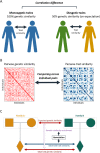Open problems in human trait genetics
- PMID: 35725481
- PMCID: PMC9208223
- DOI: 10.1186/s13059-022-02697-9
Open problems in human trait genetics
Abstract
Genetic studies of human traits have revolutionized our understanding of the variation between individuals, and yet, the genetics of most traits is still poorly understood. In this review, we highlight the major open problems that need to be solved, and by discussing these challenges provide a primer to the field. We cover general issues such as population structure, epistasis and gene-environment interactions, data-related issues such as ancestry diversity and rare genetic variants, and specific challenges related to heritability estimates, genetic association studies, and polygenic risk scores. We emphasize the interconnectedness of these problems and suggest promising avenues to address them.
Keywords: Causal variants; Complex human traits; Diversity; Epistatis; GWAS; Gene-environment interactions; Genome-wide association studies; GxE; GxG; Heritability; Human phenotypes; Linkage disequilibrium; Missing heritability; Non-additive genetic effects; PRS; Polygenic risk scores; Population structure; Rare variants; Recessive effects; Statistical genetics.
© 2022. The Author(s).
Conflict of interest statement
The authors declare that they have no competing interests.
Figures



References
-
- Lander ES (1996) The new genomics: global views of biology. Science (80- ) 274:536–539 - PubMed
Publication types
MeSH terms
LinkOut - more resources
Full Text Sources

